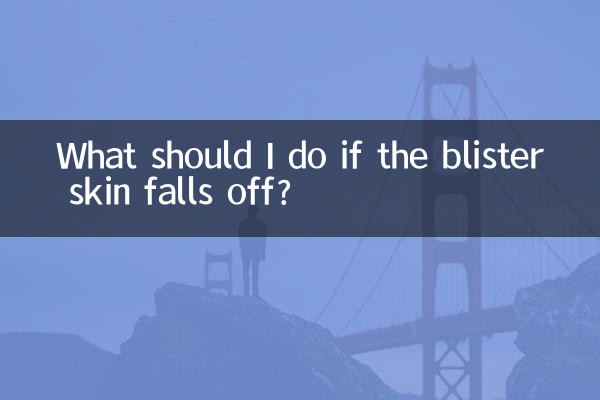What should I do if the blister skin falls off? Correct handling methods and preventive measures
In daily life, it is not uncommon for skin to develop blisters due to friction, burns or allergies. If the blister peels off, improper treatment may lead to infection or scarring. This article will combine the hot topics and hot content on the Internet in the past 10 days to provide you with structured data and introduce in detail the correct treatment methods and preventive measures for skin peeling off blisters.
1. Common causes of blistered skin peeling off

Loss of skin from blisters is usually caused by external friction, burns, or improper handling. Here are some common reasons:
| reason | illustrate |
|---|---|
| external friction | If the shoes do not fit properly, walking or exercising for a long time may cause the blisters to burst. |
| scald | Blisters form when high-temperature liquids or objects come into contact with the skin and are accidentally broken. |
| allergic reaction | Certain chemicals or plants can cause blisters when they come into contact with the skin |
| Improper handling | Opening blisters yourself or using unclean tools can lead to infection |
2. The correct way to deal with peeled skin from blisters
After the blister skin falls off, the exposed skin is susceptible to infection, so it needs to be treated in time. Here are the correct steps:
| step | How to operate |
|---|---|
| Clean the wound | Gently wash the affected area with warm water and mild soap, avoiding alcohol or hydrogen peroxide, which can cause irritation |
| disinfect | Use iodophor or medical alcohol cotton balls to gently wipe around the wound |
| Apply ointment | Apply antibiotic ointment (such as erythromycin ointment) to prevent infection |
| Cover the wound | Cover the wound with sterile gauze or a band-aid to avoid friction and contamination |
| Change dressings regularly | Change the dressing 1-2 times a day and keep the wound dry and clean |
3. Precautions for peeling off blisters
When dealing with peeled blisters, you need to pay attention to the following things to avoid infection or aggravation of the wound:
1.Do not peel off the remaining blister skin: If part of the blister skin falls off, do not forcefully tear off the remaining skin, it can protect the wound.
2.avoid touching water: Before the wound heals, try to avoid letting the wound come into contact with water, especially dirty water.
3.Do not use irritating drugs: Such as iodine or hydrogen peroxide, which may delay healing.
4.Watch for signs of infection: If the wound becomes red, swollen, pus-discharging, feverish or the pain worsens, seek medical attention promptly.
4. Measures to prevent blisters
Preventing the formation of blisters is more important than treating them afterwards. Here are practical tips for preventing blisters:
| Precautions | Specific methods |
|---|---|
| Choose the right shoes | Wear shoes that fit well and avoid wearing new shoes or high heels for long periods of time |
| Use anti-friction products | Apply anti-wear patches or Vaseline to areas prone to friction (such as heels) |
| Keep skin dry | Wear sweat-absorbent socks when exercising to prevent your feet from getting wet |
| Wear gloves | Wear gloves when doing physical work to reduce friction on your hands |
5. Common misunderstandings about peeling off blisters
Regarding the treatment of peeled skin from blisters, there are some common misunderstandings that require special attention:
1.Myth: Don’t worry about the blisters after they fall off, they will heal naturally.. Fact: Exposed wounds are susceptible to infection and need to be disinfected and bandaged promptly.
2.Myth: You can pop blisters with a needle. Fact: Opening blisters yourself can introduce bacteria and increase the risk of infection.
3.Myth: Applying toothpaste or soy sauce can treat blisters. Fact: These home remedies may irritate the skin and delay healing.
6. When do you need medical treatment?
In most cases, peeled blisters can be treated at home, but if the following conditions occur, you should seek medical attention promptly:
1. The wound is large or deep.
2. The wound shows signs of infection such as redness, swelling, pus or fever.
3. Blisters are caused by chemical burns or severe scalds.
4. Patients have diabetes or other immune system diseases, and wound healing is slow.
Conclusion
Although the peeling of the blister is a minor problem, improper treatment may lead to infection or scarring. Through the structured data in this article, you can clearly understand the correct handling methods and preventive measures. Remember, keeping the wound clean, avoiding friction, and observing it promptly are key. If the condition is serious, always seek professional medical help.

check the details

check the details